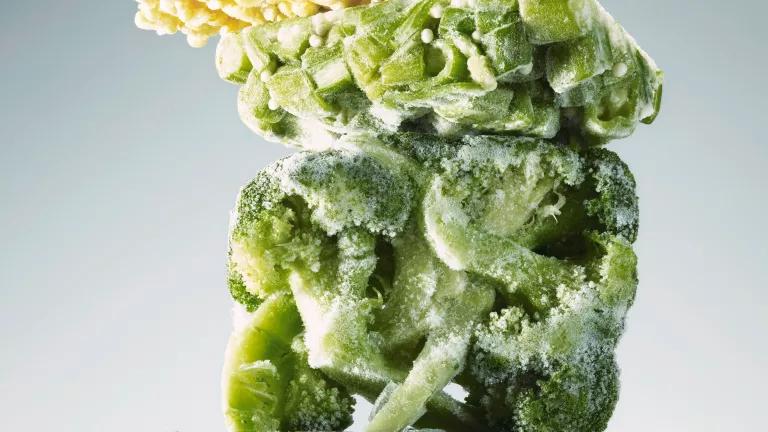Freeze More. Waste Less.
Your freezer could be the secret to keeping ingredients fresh, saving money, and reducing food waste.

Adapted from The Waste-Free Kitchen Handbook.
Imagine buying five bags of groceries, dropping two in the parking lot, and walking away. An unlikely scenario, but consider this: About 40 percent of all food produced in the United States does not get eaten. And collectively, consumers are responsible for more wasted food than farmers, grocery stores, or any other part of the food supply chain. The lettuce that went bad, the leftovers you never got around to eating, that science experiment in the back of the refrigerator you’re hoping will disappear—it all adds up. In fact, the average American household of four is throwing away $120 each month in the form of uneaten food.
Fortunately, you can fix the problem—and destress last-minute dinner quandaries in the process. Wasting less food is about keeping ingredients fresh, being creative with what you have, and getting to know your food, especially how it ages and how it is best stored. And despite its bad rap, frozen food—and freezing food—is one of the keys to cutting down on what you toss.
Embrace the freezer aisle.
Buying frozen foods can help you, your supermarket, and the whole supply chain waste less. It can also make it easier to land healthy foods on your plate on a lazy night. Less food goes to waste when it’s shipped frozen, since it’s not as perishable on the journey from the farm to your refrigerator.
But are frozen foods as good for you as fresh? The consensus is, pretty much. Research shows that the nutrient profiles of frozen fruits and vegetables are nearly equivalent to those of fresh produce. In fact, because they are often picked at their peak ripeness and frozen within hours of harvesting, they may in some cases have more nutrients than raw produce that travels for days and degrades in refrigerators.
Don’t count out frozen meats and fish.
Cave dwellers buried their hunted game in snow, and Inuits preserved seabirds in the hollowed-out bellies of seals. In this day and age, we have it pretty easy. “The technology of freezing fish has evolved to the point where it’s comparable to, if not better than, fresh fish,” explained chef Barton Seaver, who is also the director of the sustainable seafood and health initiative at Harvard’s Center for Health and the Global Environment. In fact, frozen fish is delicious, economical, nutritious, and often better for the environment. The additional travel time allowed by freezing also means the fish can be shipped by land instead of air.
Going away? Too busy to cook? Shuffle food from the refrigerator to the freezer.
Sure, you had the best intentions when you bought ingredients for that chicken Parmesan meal, but somehow the week has gone awry and now the chicken has been in the refrigerator for a few days, uncooked. What do you do? Pop it in the freezer. That extra cooked pasta you’re not in the mood to eat tomorrow? Throw that in, too. Going on vacation? Dump everything in the refrigerator into the freezer! Though some foods might alter in texture, pretty much anything can be frozen. (Note that leftovers should be frozen within three to four days.)
If you’re going to throw something into the freezer for just a couple of days, you don’t really need to worry about how you do it. One exception is fresh fruits and vegetables—those usually require a quick blanch or purée beforehand, and you should not freeze them if they have been left out of the refrigerator for more than six hours. And it goes without saying, but be sure to check for any mold, yeastiness, or slime before you get freezing, and get rid of anything with those signs of spoilage.
Generally, you can refreeze foods you’ve already thawed out.
For the most part, if frozen food has been thawed in the refrigerator, it’s fine to refreeze it, though the quality might suffer a bit. If you’ve thawed the food on your countertop for less than two hours, it’s also still okay to refreeze it. Refreezing meats or seafood after thawing in water or in the microwave, however, is not recommended, unless they’ve been cooked. Of course if you’ve cooked any previously raw, frozen foods, you can refreeze any portions you don’t eat.
Keep your frozen foods organized.
If you tend to forget what’s in the freezer, or are planning to leave the food in there for a while (ideally, not longer than a few months), it’s worth taking the time to follow some basic guidelines to help preserve the quality of the food.
Some tips for becoming a successful food-freezing champion: Freeze in portions, use airtight containers to reduce freezer burn, and do a survey of what’s in the freezer every once in a while, since quality does decline over time. If you plan a “freezer night” every week or two, you’ll be sure to get to that container of stew while it still tastes fresh—and before it is covered in ice crystals.
This NRDC.org story is available for online republication by news media outlets or nonprofits under these conditions: The writer(s) must be credited with a byline; you must note prominently that the story was originally published by NRDC.org and link to the original; the story cannot be edited (beyond simple things such as grammar); you can’t resell the story in any form or grant republishing rights to other outlets; you can’t republish our material wholesale or automatically—you need to select stories individually; you can’t republish the photos or graphics on our site without specific permission; you should drop us a note to let us know when you’ve used one of our stories.
Food Waste 101
In Planning for Climate Change, Native Americans Draw on the Past
The Smart Seafood and Sustainable Fish Buying Guide